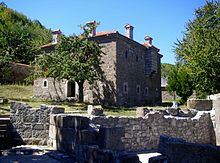Tower houses in the Balkans

A distinctive type
The practice began during the decline of Ottoman power in the 17th century[1] and flourished until the early 20th century. The tower houses were typically made out of stone, rose three or four storeys, and were square or rectangular in shape.[1] They served both military (defence, watchtower) and civilian (residential) purposes in order to protect the extended family.[3]
In Albania

Types of tower houses in
Certain kullë were used as places of isolation and safe havens, or "locked towers" (
There are also instances of fortified tower houses in Gjirokastër built in the 13th century, pre-dating Ottoman conquest.[7]
In Bosnia and Herzegovina
Towers and odžaks are usually built next to each other as fortification and residential buildings. Although easily confused they differ in material and purpose. However, sometime one building can be both at once. There used to be over three hundred such facilities in the territory of
In Bulgaria
Examples of fortified residential towers in Bulgarian lands include the 16th-century
The tower in
Hrelyo's Tower, built in 1334–5 by prōtosebastos Hrelja in the courtyard of the Rila Monastery, is a pre-Ottoman example of an autonomous tower that served residential as well as defensive purposes. Besides featuring habitable floors, the 75 feet (23 m) Hrelyo's Tower also includes an Orthodox chapel on its top floor.[14]
In Greece

The tradition of tower houses in Greek architecture existed since Byzantine and Frankish times.[15]
Although the
Alongside the fortified houses of Mani (called xemonia), there are also residential towers (koule) of Ottoman origin.
Greek architects have claimed that the Albanian tower houses developed under Greek influence.[17]
In Kosovo

In
Aspects of kulla life are strongly influenced by Muslim culture, especially the segregation between men and women in social spaces and entrances.[20] The kullas' characteristic double sets of entrances and staircases (main and side) reflect this division, since only the side entrance and staircase lead to the private family quarters. Kullas are also well-suited to the Kosovan climate as their construction allows them to remain cool in the summer and warm during winter.[20]
Examples include Jashar Pasha's Tower, Haxhi Zeka's Tower, Xhafer Syla's Tower, Mazrekaj Tower, Janjevo Tower, Tomić's Tower, and Osdautaj's Tower.
In Serbia

Nenadović's Tower (Serbian: Кула Ненадовића) was built by Jakov Nenadović in springtime 1813 in Valjevo, Šumadija.[21] Initially it was used by rebels during the First Serbian Uprising of the Serbian Revolution for military purposes. Ottomans later used it as prison.[22]
In Montenegro
Examples include the Ganić tower house in Rožaje.
See also
- Culă, towers built by boyars in what is today Romania.
- Architecture of Kosovo
- Architecture of Serbia
- Architecture of Montenegro
- Architecture of Albania
References
- ^ a b c Grube-Mitchell 1978, p. 204: "a distinctive form of defensive tower-dwelling, the kula, developed among both the Christian and the Muslim communities during the insecure period of the decline of the Ottoman authority in the 17th century ..."
- ^ Fishta-Elsie-Mathie-Heck 2006, p. 435
- ^ a b Greville Pounds 1994, p. 335: "In southeastern Europe, where the extended family was exemplified as nowhere else in the western world, the home itself was often protected, giving rise to the kula or tower- house."
- ^ Stubbs-Makaš 2011, p. 392
- ^ Epirus, 4000 years of Greek history and civilization. p. 334
- ISBN 978-1-74104-729-5. Retrieved 11 May 2012.
- ^ Internationale Tourismusattraktionen in Mittel- und Südosteuropa. Österreichisches Ost- und Südosteuropa-Institut, 1999, p. 2.
- ^ a b Kreševljaković, Hamdija (1991). Kule i odžaci u Bosni i Hercegovini [Towers and odžaks in Bosnia and Herzegovina] (PDF) (in Serbo-Croatian) (Hamdija Kreševljaković, Izabrana djela I ed.). Sarajevo: Veselin Masleša. pp. 1–16. Retrieved 1 May 2023.
- ISBN 9780982261996.
- ISBN 9781841621555.
- ^ "Pirkova Tower". Tourism Kyustendil. Retrieved 18 May 2012.
- ^ "Кулата в Тешово с първото ВиК" [The tower in Teshovo with the first water supply]. Стандарт (in Bulgarian). Стандарт нюз АД. 2011-08-04. Retrieved 18 May 2012.
- ^ Пелтеков, Александър (2001). "Старата кула" [The old tower] (in Bulgarian). Teshovo.com. Retrieved 18 May 2012.
- ^ Thomas, John Philip; Hero, Angela Constantinides; Constable, Giles (2000). Byzantine Monastic Foundation Documents: A Complete Translation of the Surviving Founders' Typika and Testaments, Volume 1. Dumbarton Oaks. p. 126.
- ISBN 978-0-19-530593-7.
- ^ Sigalos 2004, p. 53
- ^ Sigalos 2004, p. 48: "The Albanian kula, or tower house, for example, was regarded to have developed under Greek influence (Megas 1951, 1967)."
- ^ Rassam 2001, p. 2
- ^ a b Rassam 2001, p. 3
- ^ a b Rassam 2001, p. 6
- ^ "Kula Nenadovića" (in Serbian). Valjevozavas.net. Retrieved 18 May 2012.
Kula Nenadovića je svakako simbol grada Valjeva. Podignuta je u proleće 1813. godine ...
- ISBN 9788676860678. Retrieved 18 May 2012.
Kula Nenadovica (Nenadovic's Tower) ... was built at Jakob Nenadovic's command in 1813. He was Minister for Private Affairs. It served for military purposes. Turks used it as a prison later
Sources
- Gjergj Fishta (3 March 2006). The Highland Lute: (Lahuta E Malcís) : the Albanian National Epic. Translated by Robert Elsie; Janice Mathie-Heck. I.B.Tauris. pp. 435–. ISBN 978-1-84511-118-2. Retrieved 10 May 2012.
- Greville Pounds, Norman John (27 May 1994). The Culture of the English People: Iron Age to the Industrial Revolution. Cambridge University Press. ISBN 9780521466714. Retrieved 10 May 2012.
- Ernst J. Grube, George Michell (1978). Architecture of the Islamic world: its history and social meaning, with a complete survey of key monuments. Morrow. ISBN 9780688033248. Retrieved 10 May 2012.
- Sigalos, Eleftherios (2004). Housing in medieval and post-medieval Greece, Volume 1. Archaeopress. ISBN 9781841716411. Retrieved 10 May 2012.
- John H. Stubbs, Emily G. Makaš; Mounir Bouchenaki (2011). Architectural Conservation in Europe and the Americas. John Wiley and Sons. ISBN 9780470900994. Retrieved 11 May 2012.
- Rassam, Sahar (September 11, 2001). Kulla: A Traditional Albanian House Type in Kosovo (PDF). UNESCO-ICOMOS World Millennium Congress, Session 2 (continued) - Historic towns. Paris.
